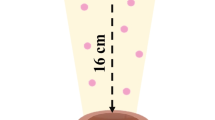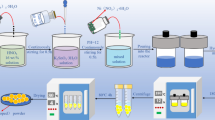Abstract
Typically, Sn cannot be finished on Ni and Ag surfaces via the immersion process. In this work, through galvanic reaction, immersion Sn finish was processed on an immersion Ag finish coexisting with a Ni surface. Herein, the detailed mechanism of the reduction of Sn2+ ions on the immersion Ag surface through galvanic reaction is reported. Through transmission electron microscopy and X-ray diffraction analysis, the uncommon Ag4Sn phase, instead of the common Ag3Sn phase, was confirmed to form during the Sn immersion of the Ag immersion layer. The Ag4Sn phase was found to form between the Ag grains in the immersion Sn layer. The mixed Ag/Ag4Sn structure in the immersion Sn layer can be explained by the galvanic reaction. The preferred formation of the Ag4Sn during the Sn immersion of the Ag immersion layer is discussed from the viewpoint of thermodynamics. The changes in the Gibbs free energy of the formation of the Ag3Sn and Ag4Sn phases were calculated as − 3.67 and − 8.89 kJ/mol, respectively. This confirms that the Ag4Sn phase is the favorable phase formed in the immersion Sn over the immersion Ag layer.













Similar content being viewed by others
Data availability
The raw/processed data required to reproduce these findings cannot be shared at this time as the data also form part of an ongoing study.
References
M. Palaniappa, S.K. Seshadri, Friction and wear behavior of electroless Ni–P and Ni–W–P alloy coatings. Wear 265(5–6), 735–740 (2008)
M. Yan, H.G. Ying, T.Y. Ma, Improved microhardness and wear resistance of the as-deposited electroless Ni–P coating. Surf. Coat. Technol. 202(24), 5909–5913 (2008)
Y.-C. Lin, K.J. Wang, J.G. Duh, Detailed phase evolution of a phosphorous-rich layer and formation of the Ni-Sn-P compound in Sn-Ag-Cu/electroplated Ni-P solder joints. J. Electron. Mater. 39(3), 283–294 (2010)
Zhu W.H et al.(2008) Drop reliability study of PBGA assemblies with SAC305, SAC105 and SAC105-Ni solder ball on Cu-OSP and ENIG surface finish. In: 2008 58th Electronic Components and Technology Conference. IEEE. p. 1667-1672
P.A.M.R.P. Snugovsky, P. Arrowsmith, M. Romansky, Electroless Ni/immersion Au interconnects: investigation of black pad in wire bonds and solder joints. J. Electron. Mater. 30(9), 1262–1270 (2001)
Medgyes B et al.( 2016) Electrochemical migration of Sn and Ag in NaCl environment. In: 2016 IEEE 22nd International Symposium for Design and Technology in Electronic Packaging (SIITME). IEEE. p. 274-278
S.F.M. Amli et al., Effect of surface finish on the wettability and electrical resistivity of Sn-30 Ag-05 Cu solder. IOP Conf. Ser. 701, 012029 (2019).
S.Z. Kure-Chu, H. Yashiro, Corrosion resistance of multilayered Sn/Ag3Sn films electroplated on Cu alloys for highly reliable automotive connectors. J. Electrochem. Soc. 161(10), C441 (2014)
T. Takenaka, M. Kajihara, Fast penetration of Sn into Ag by diffusion induced recrystallization. Mater. Trans. 47(3), 822–828 (2006)
A. Lis et al., Early stage growth characteristics of Ag3Sn intermetallic compounds during solid–solid and solid–liquid reactions in the Ag–Sn interlayer system: experiments and simulations. J. Alloy. Compd. 617, 763–773 (2014)
Y.H. Jo et al., Synthesis and characterization of highly conductive Sn–Ag bimetallic nanoparticles for printed electronics. J. Nanopart. Res. 14(4), 782 (2012)
B. Gollas et al., Thin layer in situ XRD of electrodeposited Ag/Sn and Ag/In for low-temperature isothermal diffusion soldering. Intermetallics 16(8), 962–968 (2008)
P.J. Rossi et al., Dependence of intermetallic compound formation on the sublayer stacking sequence in Ag–Sn bilayer thin films. Acta Mater. 103, 174–183 (2016)
A.A. Wronkowska et al., Spectroscopic ellipsometry study of the dielectric response of Au–In and Ag–Sn thin-film couples. Appl. Surf. Sci. 256(15), 4839–4844 (2010)
N. Yuantao, Z. Xinming, Metastable extension of solid solubility of alloying elements in silver. J. Alloy. Compd. 182(1), 131–144 (1992)
I. Karakaya, W.T. Thompson, The Ag-Sn (silver-tin) system. Bull. Alloy Phase Diagr. 8(4), 340–347 (1987)
C.C. Theron et al., First phase formation at interfaces: comparison between walser-bené and effective heat of formation model. Mater. Chem. Phys. 46(2–3), 238–247 (1996)
R. Pretorius et al., Compound phase formation in thin film structures. Crit. Rev. Solid State Mater. Sci. 24(1), 1–62 (1999)
H. Flandorfer et al., Interfaces in lead-free solder alloys: enthalpy of formation of binary Ag–Sn, Cu–Sn and Ni–Sn intermetallic compounds. Thermochim. Acta 459(1–2), 34–39 (2007)
C.R. Hubbard, R.L. Snyder, RIR-measurement and use in quantitative XRD. Powder Diffr. 3(2), 74–77 (1988)
J.R. Abbott, D.R. Miller, D.J. Netherway, Plastic deformation of ß and γ phase silver-tin alloys. J. Mater. Sci. 19(10), 3255–3265 (1984)
B.F. Dyson, Diffusion of gold and silver in tin single crystals. J. Appl. Phys. 37(6), 2375–2377 (1966)
Acknowledgements
We are grateful for the financial support from MOST 108-2221-E-008-045-MY3 and MOST 107-2221-E-008-042-MY3. The information consultancy of ENIG and immersion Ag development trends provided by Taiwan Uyemura Co., Ltd. are greatly appreciated.
Author information
Authors and Affiliations
Corresponding author
Additional information
Publisher's Note
Springer Nature remains neutral with regard to jurisdictional claims in published maps and institutional affiliations.
Rights and permissions
About this article
Cite this article
Wu, C.Y., Fu, K.L., Lin, Y.X. et al. Study of galvanized Sn-finished Ag surface. J Mater Sci: Mater Electron 32, 18605–18615 (2021). https://doi.org/10.1007/s10854-021-06306-6
Received:
Accepted:
Published:
Issue Date:
DOI: https://doi.org/10.1007/s10854-021-06306-6




